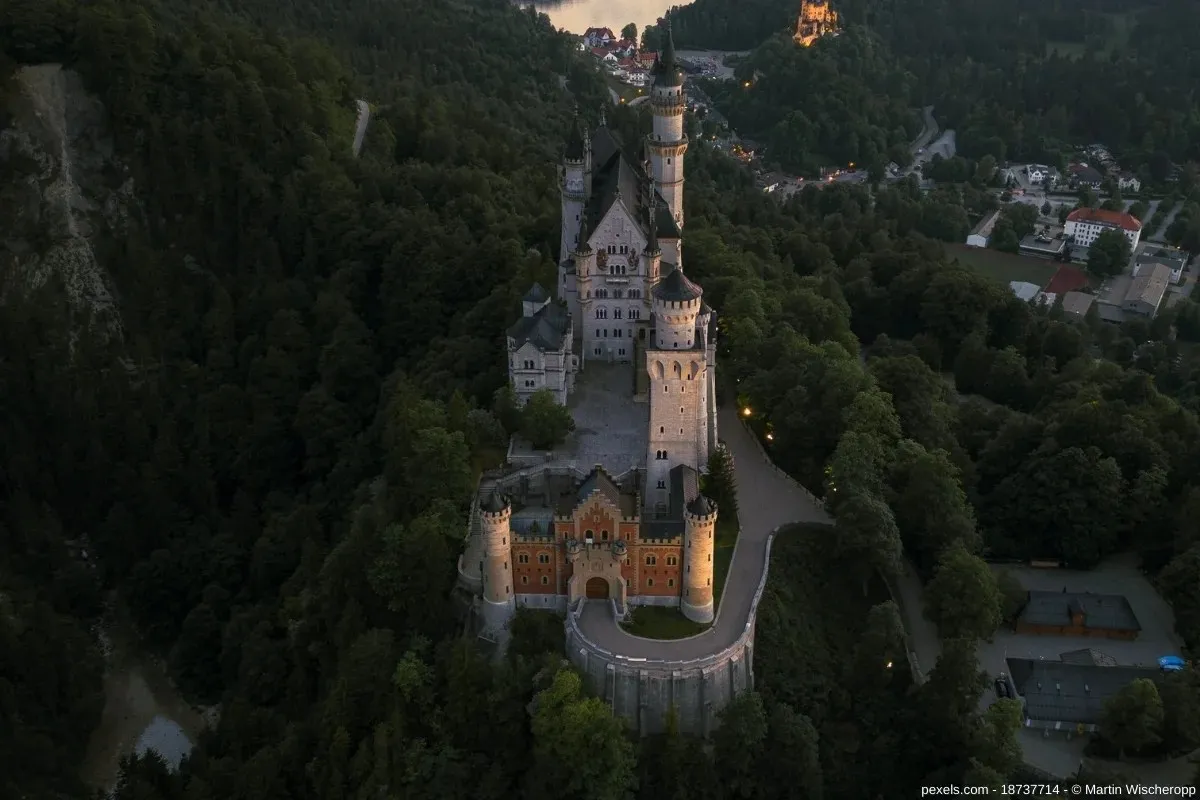Neuschwanstein Castle and “crazy” King Ludwig

Nestled amidst the enchanting landscapes of the Bavarian Alps, Neuschwanstein Castle stands as a testament to the eccentricities of one of nineteenth century history’s most enigmatic royal rulers – “crazy” King Ludwig II. The tale of Neuschwanstein and its creator, Ludwig II, unfolds like one of Richard Wagner’s stage productions that inspired him so much, rich with dramatic twists, romantic nostalgia, and an operatic climax that has fueled speculation for generations. King Ludwig was as remote and inaccessible as the castles he built, and his life had as many ups and downs as the mountains he built them in.
The Bavarian Dream.
Bavaria, renowned for its inspiring landscapes and rich cultural heritage, serves as the picturesque backdrop to the story. In the very heart of this enchanting Alpine region, Neuschwanstein Castle, often referred to simply as Neuschwanstein, manifests itself to the visitor as something from another world almost, a fairytale kingdom.
King Ludwig II, also known as the “Swan King” due to his association with the castle, left an indelible mark on Bavaria. A monarch of paradoxes, Ludwig II’s reign was characterized by an eccentric personality that set him apart from his contemporaries. His Bavarian retreat in the clouds was conceived not only as a royal residence but also as a refuge – a place where he could retreat from the world, and live the life of his fanstasies.
Schloss Neuschwanstein is a testament to Ludwig II’s romantic nostalgia for medieval culture. Bavaria’s landscapes, with their rolling hills and serene lakes, operated as a theatrical backdrop for Ludwig II’s architectural dreams. The castle’s neo-Romanesque and neo-Gothic elements pay homage to a bygone era, capturing the king’s fervent desire to live in the spirit of medieval chivalry and the age of knights and Romance and the Holy Grail. This was his retreat from the confusion and chaos of modern life and society.
Ludwig II’s eccentricities extended beyond his architectural endeavors. From an early age, the king was fuelled by an intense obsession with the operas of Richard Wagner, the great composer of nineteenth century Germany, whose works left an indelible mark on the cultural landscape. Ludwig II’s infatuation with Wagner is a recurrent theme in his life. King Ludwig cannot be understood separately from the role the arts played in shaping and motivating him.
As one explores the ornate chambers, state rooms and royal apartments of Neuschwanstein Castle, the Wagnerian ambiance is palpable. The castle’s halls resonate with echoes of Wagner’s operas, transforming the stone walls into a harmonious tapestry of artistic expression. Ludwig II’s desire to intertwine his architectural marvel with the musical world of Wagner illustrates the intimate connection between the Swan King and the composer.
Ludwig II’s architectural legacy extends beyond Neuschwanstein. He is also responsible for Linderhof and Herrenchiemsee palaces, two of the jewels in Bavaria’s very rich architectural crown. Near Neuschwanstein can also be seen his childhood home of Hohenschwangau. Itself a great example of medieval revivalism, Hohenschwangau served as one of the original inspirations for Ludwig. Hohenschwangau Castle lies in the valley above which Neuschwanstein towers. Neuschwanstein looks down on Hohenschwangau Castle, both literally and in other senses, as Hohenschwangau was the inspirational foundation upon which Neuschwanstein was built.
Linderhof is very different from both Neuschwanstein Castle and Hohenschwangau. Linderhof is more of a baroque jewel than a misty mountain retreat. What Herrenchiemsee and Linderhof Palace, and all Ludwig’s castles and palaces share in common, however, is the king’s need to escape a world he found evermore frightening, ugly and confusing. Evidence of this can be seen everywhere in Herrenchiemsee and Linderhof Palace, but Neuschwanstein Castle above all is the great testement to König Ludwig II’s (to give him his German title) rejection of modern life in favour of a fantasy world of his own making.
King Ludwig II’s reign was marred by both political turmoil, huge constitutional change, and financial controversy. It was during his reign that Bavaria lost is independence and was incorprated into the new Germany. The king’s lavish architectural projects, including Neuschwanstein Castle, strained Bavaria’s coffers to breaking point. Critics labeled him the “Mad King” for his seemingly endlessly extravagant pursuits. The result was growing tensions within the Bavarian government, and between the king and his ministers. This followed from earlier moves on the part of the government to force a break between Ludwig and his beloved Wagner. This turbulent period laid the groundwork for Ludwig II’s removal from power, a traumatic event which continues to be a source of debate and controversy to this day.
The circumstances surrounding the aftermath of King Ludwig II’s removal from the throne remain shrouded in mystery. Accused of insanity and declared unfit to rule, Ludwig II was forcibly removed from his position in 1886. The question of whether the king was genuinely mentally unstable or if political motivations fueled his removal has fueled debates for decades. Bavaria, once enchanted by its Swan King, was shocked by his sudden and mysterious death in an apparent drowning accident in Lake Starnberg, which occured within days of his removal from power.
Despite the controversy surrounding Ludwig II, Neuschwanstein Castle stands today as a symbol of Bavarian cultural resilience and the Alpine kingdom’s unique architectural legacy. The castle is forever associated with Bavaria’s mountainous landscape – and ithe landscape with the castle. It is impossible to imagine Bavaria today without the “mad” king’s great gift to his former kingdom. Recently declared one of the wonders of the modern world, it attracts vast numbers of visitors from every corner of the globe, who travel to the nearby town of Füssen, and then walk or take the shuttle bus uphill to experience the fairytale-like vision. Our advice: walk further up the hill to the Marienbrücke suspension bridge hanging almost impossibily in the air above the breathtaking Pöllat gorge and look down on Mad King Ludwig’s majestic vision for yourself.
The tale of Neuschwanstein Castle and King Ludwig II is a captivating journey through the landscapes of Bavaria and the intricate recesses of the Swan King’s mind. The dramatic fusion of medieval nostalgia, Wagnerian obsession, and political intrigue tells an endlessly gripping story of a monarch whose legacy endures to this day among the towers and turrets of Neuschwanstein. As Bavaria continues to enchant with its fairy-tale landscapes, the story of Neuschwanstein Castle remains a testament to the enduring allure of the “crazy” King Ludwig II.
